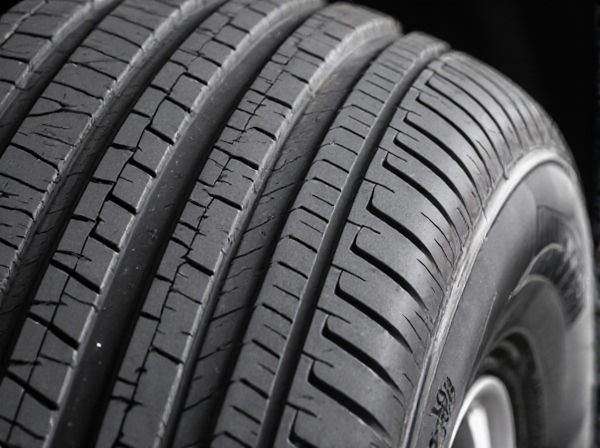
Photo illustration: Multi-radius Tread vs Single-radius Tread
Multi-radius treads provide enhanced traction and smoother handling by varying the tread curve to adapt to different driving conditions, unlike single-radius treads that maintain a uniform curvature. Your vehicle benefits from better cornering stability and improved grip on diverse surfaces with multi-radius designs, which distribute pressure more evenly across the tire. Single-radius treads may offer simplicity and consistent wear but often lack the adaptive performance that multi-radius treads deliver.
Table of Comparison
| Feature | Multi-radius Tread | Single-radius Tread |
|---|---|---|
| Tread Design | Multiple curvature zones for varied contact pressure | Uniform curvature for consistent contact |
| Performance | Enhanced grip and handling on diverse surfaces | Stable performance on smooth, consistent roads |
| Wear Pattern | Balanced wear due to adaptive tread shape | Uniform wear but may degrade faster on uneven surfaces |
| Ride Comfort | Smoother ride with vibration reduction | Standard comfort level |
| Applications | Sports cars, performance vehicles, mixed road conditions | Daily commuters, city driving, highway use |
| Cost | Generally higher due to advanced design | More affordable, simpler manufacturing |
Introduction to Tire Tread Geometry
Multi-radius tread designs enhance tire performance by incorporating varying curvature radii, optimizing contact with the road surface for improved grip and durability. Single-radius treads feature a uniform curvature, providing consistent wear patterns but potentially less adaptability to diverse driving conditions. Understanding tire tread geometry is crucial for selecting the appropriate tire, as it directly influences traction, handling, and overall vehicle safety.
What Is Multi-radius Tread?
Multi-radius tread refers to a tire design featuring multiple curved surfaces with varying radii along the tread profile, enhancing grip and handling compared to single-radius treads that have a uniform curvature. This design allows better adaptation to different road conditions by optimizing contact patches during cornering, braking, and straight-line driving. Tires with multi-radius tread patterns improve traction, stability, and overall performance in both wet and dry environments.
What Is Single-radius Tread?
Single-radius tread features a consistent curve across the tire's contact patch, providing uniform ground contact and predictable handling performance. This tread design enhances vehicle stability by maintaining even tire pressure distribution during cornering and straight-line driving. Single-radius treads are commonly used in standard passenger vehicles for balanced traction and tire wear.
Design Differences Between Multi-radius and Single-radius Treads
Multi-radius treads feature varied curvature patterns across the tire surface, enhancing traction and wear resistance by optimizing contact patches for different driving conditions. Single-radius treads maintain a uniform curvature throughout, promoting consistent wear and simpler manufacturing but offering less adaptability to varying terrains. The design complexity in multi-radius treads allows for improved grip and performance in diverse environments compared to the straightforward profile of single-radius treads.
Performance Comparison: Grip and Handling
Multi-radius treads enhance grip by providing varied contact patches that adapt dynamically to different road surfaces, improving traction during cornering and braking. Single-radius treads offer consistent grip on uniform surfaces but may lack the versatility needed for complex maneuvers, resulting in less precise handling performance. Performance metrics indicate multi-radius designs deliver superior control and stability, especially in wet or uneven conditions.
Impact on Tire Wear and Longevity
Multi-radius tread designs distribute contact pressure more evenly across the tire surface, reducing localized wear and enhancing overall tire longevity. Single-radius treads often concentrate stress on specific areas, accelerating tread wear and potentially shortening the tire's lifespan. Optimizing tread radius based on vehicle type and driving conditions can significantly improve tire durability and performance.
Wet and Dry Traction Analysis
Multi-radius tread patterns enhance wet and dry traction by offering varied contact patches that adapt to different road conditions, improving grip and stability. Single-radius treads typically provide consistent contact angles but may lack optimal water dispersion, leading to reduced performance on wet surfaces. Advanced multi-radius designs promote superior hydroplaning resistance and better braking efficiency across diverse terrains compared to traditional single-radius treads.
Ride Comfort and Noise Levels
Multi-radius treads provide enhanced ride comfort by distributing pressure more evenly across the tire surface, reducing vibration and road impact noise compared to single-radius treads. The varied curvature of multi-radius designs minimizes tread block deformation, leading to quieter operation and improved absorption of irregularities on different road surfaces. Single-radius treads, with uniform curvature, often generate higher noise levels due to consistent contact patches creating repetitive sound patterns and less adaptability to varying terrain roughness.
Applications and Ideal Use Cases
Multi-radius treads provide enhanced grip and smoother transitions, making them ideal for vehicles requiring adaptive traction across diverse terrains such as off-road SUVs and performance cars. Single-radius treads excel in consistent traction and even wear on smooth, paved surfaces, making them suitable for daily commuter vehicles and highway driving. Choosing between these tread types depends on driving conditions, with multi-radius offering versatility for mixed-use and single-radius optimized for stability and longevity on regular roads.
Choosing the Right Tread for Your Vehicle
Choosing the right tread for your vehicle depends on driving conditions and performance needs. Multi-radius treads offer enhanced grip and stability on varied surfaces by combining multiple curves, making them ideal for off-road and performance vehicles. Single-radius treads provide consistent contact with the road, promoting even wear and better fuel efficiency, best suited for everyday commuting and highway driving.
 caratoz.com
caratoz.com